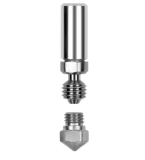
All About All-Metal Hot Ends: Basics and Troubleshooting
Thinking about making the switch to an all-metal hot end for your 3D printer or having trouble with your upgrade? This guide presents the all-metal hot end basics and provides some quick troubleshooting tips for maintaining clean and clear extrusion.
All-metal hot ends are incredibly popular upgrades for FDM 3D printers. The PTFE element in the heated assembly can limit the heating ability of the printer, and these all-metal hot ends are more versatile than their stock counterparts. However, they're notorious for jamming problems. In this article, we cover the basics of all-metal hot ends and what you need to know to keep them running smoothly.

(Source: store.micro-swiss.com; Micro Swiss MK10 All Metal Hotend Kit)
What is an all-metal hot end?
Conventional 3D printer hot ends are outfitted with a PTFE tube that extends along the nozzle and is seated against the heating block. This tube typically begins to degrade at temperatures over 250 °C, and the seal attaching it to the nozzle can shift over time, making it limited in utility for some materials.
Further, this tube can emit toxic fumes at very high temperatures and requires replacement after frequent high-temperature printing. Certain 3D printing filaments, such as polycarbonate materials, require very high printing temperatures and thus can only be printed with all-metal hot ends.
Pros
Versatility
If you want to print with a wide variety of filaments that require high working temperatures, getting an all-metal hot end is highly recommended.
Durability
In conventional hot ends, you can almost guarantee that your PTFE tube will cause problems over time as it degrades after high-temperature use. All-metal hot ends completely undermine this issue.
Cons
Retraction settings
Working with high-temperature filament is a bit more involved than working with conventional filaments. These special filaments may stick to the wall of the heat break if retracted too quickly. You may want to run some test prints to identify the right retraction speed, which is usually lower than what you’d expect for conventional filament.
We recommend starting by setting the retraction distance to 3.5–4 mm and speed to 45 mm/s.

Clogging
Clogging is the biggest issue most people face when working with all-metal hot ends. Owing to these high working temperatures, the filament will be subject to harsh thermal gradient as the extruded material cools.
The heat break conducts heat much faster without a PTFE tube, so if there is any heat creep from the heat block, the filament may melt before it is extruded. As soon as the heating element cools, the melted filament will re-solidify, causing a clog. This problem isn’t only experienced when working with high-temperature materials, either. It’s quite common with low-temperature PLA.
While we’ve covered general troubleshooting in some guides before, this article will provide some essential tips on working all-metal hot ends specifically to minimize jamming risk and fix clogs when they occur.
Troubleshooting clogged all-metal hot ends
Check heat sink temperature
All-metal hot ends are outfitted with heatsinks that act as the cold component to which the hot end is secured on your 3D printer.
When the heatsink does not cool properly, heat from the heated areas will move up, which is called heat creep. Heat creep causes filament in the heatsink to begin to melt, exhibiting the same tackiness that you expect during extrusion. As the filament softens, it conforms and sticks to the walls of the heatsink, forming a clog.
If you’re unsure whether this is your problem, check your heatsink temperature. If it is warm to the touch, you may have to externally control the heatsink temperature by installing a stronger heatsink cooling fan or getting a better fan duct to direct the air more effectively.
Change the retraction settings
The retraction settings on your 3D printer are crucial for managing stringing and oozing during extrusion. Retraction involves pulling the filament back up into the hot end after extrusion, which can significantly improve print quality and reduce over-extrusion. Speed and length are the major retraction settings you can alter in your slicer.
If the retraction length is too high, melted filament may be pulled back in from the print bed, leading to a similar clogging problem as a malfunctioning heat sink.
We recommend slightly reducing the retraction distance to the lower end of your filament manufacturer’s recommendations and running at test print, like this specific test on Thingiverse.
Check your hot end alignment
Because all-metal hot ends lack a PTFE tube, which guides the filament through the extrusion, so all-metal hot ends are at greater risk from exhibiting disrupted filament paths than their non-all-metal counterparts.
The filament path can get disrupted owing to components in your hot end becoming misaligned. Smooth passage of filament depends on all parts being properly attached and aligned, specifically for the thin component that connects the heater block and heatsink called the heat break.

Check the filament quality
Sometimes, older filament or hygroscopic filament that you have had to dry out may have developed an uneven thickness along its length, which can lead to clogging. This is particularly problematic when paired with the heating problems noted above.
If you think your filament may be to blame for problematic extrusion, measure the filament diameter at random points along a length of material using calipers or a micrometer. If the diameter appears to vary by more than 50 microns, we recommend switching the spool or jumping to a new brand entirely if the filament is relatively new, as this indicates a manufacturing error.


Leave a comment